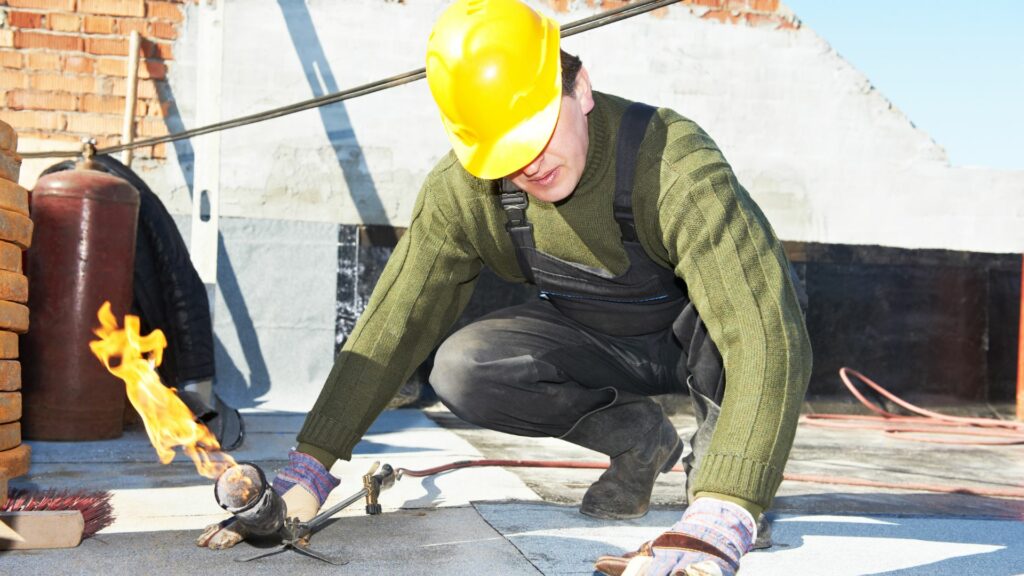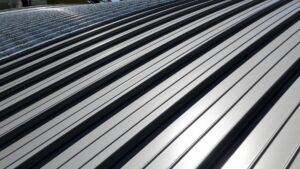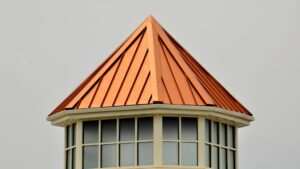Leaky roofs, escalating energy bills, and the constant battle against the elements are the bane of every commercial facility manager’s existence. These persistent challenges not only drain resources but also compromise the integrity of valuable assets housed within.
Amidst this struggle, the question arises: What Is TPO Roofing? Thermoplastic Polyolefin (TPO) roofing is a single-ply roofing membrane that offers a trifecta of benefits crucial for commercial buildings: exceptional durability against tears and punctures, outstanding energy efficiency through its reflective surface, and superior leak resistance.
By addressing these key pain points, TPO roofing stands out as a smart choice for facility managers looking to safeguard their operations against weather-induced disruptions and optimize their energy consumption. Read on to discover how TPO roofing can transform your facility’s defenses and contribute to a more sustainable, cost-effective future.
What is TPO Roofing?
TPO roofing is a type of material that’s become a go-to choice for many commercial and industrial buildings. This roofing material is made from a blend of polypropylene and ethylene-propylene rubber. This gives it a unique set of properties that stand out in the roofing world.
The production of TPO roofing involves rolling the material out into large sheets. These are then applied to the roof in a single layer, making it a “single-ply” roofing system.
Advantages of TPO Roofing

TPO roofing offers several benefits that make it an appealing choice for a commercial roof. One of the most significant advantages is its potential for energy savings.
The reflective nature of TPO roofing helps deflect sunlight and heat away from the building. This reduces the need for air conditioning and, in turn, lowers energy bills. It can lead to substantial cost savings over the lifespan of the roof, especially in areas with high temperatures and strong sunlight.
Durability is another key benefit of TPO roofing. It’s known for its resistance to tears, punctures, and impacts. This means it can last a long time without needing repairs or replacement.
This durability is partly due to the material’s flexibility, which allows it to withstand building movement and thermal expansion without sustaining damage. The flexibility of TPO roofing material means it can move with the building as it settles and shifts over time. This reduces the risk of cracks and splits.
Leak prevention is a standout feature of TPO roofing, thanks to its heat-welded seams. These seams are stronger than the membrane itself which makes them highly resistant to leaks.
This is a significant advantage over older roofing systems with seams that were glued or taped together. These could fail over time and lead to water damage.
Finally, the cost-effectiveness of TPO roofing cannot be overstated. Not only is it competitively priced at installation, but its durability and low maintenance requirements mean reduced costs over the roof’s life.
Property owners can expect fewer repairs and longer intervals between roof replacements. This makes TPO an economically wise choice for protecting their investment.
Installation of TPO Roofing

Installing TPO roofing is a process that requires precision and expertise. The journey begins with preparing the roof surface to ensure it’s clean, dry, and flat. This preparation is crucial for a successful installation, as it affects the overall performance and longevity of the roofing system.
The TPO sheets are then rolled out and attached to the roof, either by mechanical means, with adhesive or by heat welding. Heat welding the seams creates a watertight bond that is strong and highly resistant to leaks. This makes it a preferred method for joining TPO sheets.
Professionals often highlight the importance of considering insulation options during the installation. Adding insulation beneath the TPO membrane can enhance the roof’s energy efficiency which contributes to lower heating and cooling costs.
This step is vital for buildings in climates with extreme temperatures, as it helps regulate the indoor environment and adds to the energy savings provided by the TPO roofing itself.
Maintenance of TPO Roofing
TPO roofing systems are celebrated for their low maintenance requirements. However, regular inspections and basic upkeep are essential to extend their lifespan and ensure they continue to perform effectively.
Routine checks should ideally be twice a year. They will help identify and address any potential issues, such as minor tears or seam problems, before they become significant problems.
Cleaning the roof is also a part of maintaining a TPO system. Removing debris and dirt can prevent damage and ensure the reflective surface continues to work efficiently for energy savings.
Choosing a Skilled TPO Roofing Partner

A skilled and experienced roofing contractor can make all the difference in ensuring your roofing system is installed correctly and maintained to last. The ideal service provider will not only have years of experience working with TPO materials but also a solid track record of successful installations and satisfied customers.
Look for a roofing service that offers comprehensive solutions, from initial assessment and customized design to professional installation and after-care maintenance.
A company that specializes in TPO roofing should be able to guide you through the selection process, including choosing the right insulation options to maximize energy efficiency and meet your building’s specific needs.
Experience is key when selecting a TPO roofing service. Providers with extensive knowledge about TPO systems will ensure that your roof is not only installed to the highest standards but also equipped to withstand the elements for years to come.
Moreover, a reputable roofing service will offer ongoing support, including regular maintenance checks and repairs, to keep your roof in top condition.
A Smart Choice for Today’s Commercial Buildings
So, what is TPO roofing? Simply put, it’s a cutting-edge solution for commercial and industrial buildings that combines durability, energy efficiency, and water resistance into one powerful package.
Eagle Rivet Roof Service Corporation specializes in harnessing these advantages to protect and enhance your assets. Our expertise in TPO installations and maintenance is unmatched. We ensure your roofing solution is not only state-of-the-art but also tailored to your specific needs.
Ready to secure your property with a roofing system that promises longevity, efficiency, and performance? Contact us today to schedule your complimentary TPO roofing consultation.
What is TPO Roofing (FAQs)
What is TPO roofing, and how does it differ from other roofing materials?
TPO roofing, also known as Thermoplastic Polyolefin roofing, is a single-ply membrane made from a blend of polypropylene and ethylene-propylene rubber. It distinguishes itself through exceptional durability, energy efficiency, and leak resistance, making it an optimal choice for commercial and industrial buildings seeking long-term protection against environmental elements.
What are the benefits of choosing TPO roofing for my commercial facility?
Opting for TPO roofing offers numerous advantages. Its reflective surface aids in reducing heat absorption, leading to lower energy costs and increased occupant comfort. Additionally, TPO roofing boasts superior durability against tears and punctures, coupled with outstanding leak resistance. This results in reduced maintenance requirements and long-term cost savings compared to traditional roofing materials.
How is TPO roofing installed, and what is involved in the process?
The installation process of TPO roofing involves meticulous preparation of the roof surface to ensure cleanliness and flatness. Following this, the TPO sheets are applied using mechanical fastening, adhesive, or heat welding techniques to create a seamless and watertight barrier. Heat welding the seams enhances the roof’s durability and longevity, ensuring superior performance over time.
What maintenance is required for TPO roofing, and how often should it be performed?
TPO roofing systems are renowned for their low maintenance requirements. Regular inspections, ideally conducted semi-annually, are recommended to identify and address potential issues promptly. Routine cleaning to remove debris and dirt is essential to preserve the reflective surface and optimize energy efficiency. Timely repair of minor tears or seam problems is crucial to prevent larger issues from developing.
Why should I choose a skilled TPO roofing contractor for installation and maintenance? Selecting a skilled and experienced roofing contractor is crucial to ensuring the successful installation and long-term performance of your TPO roofing system. A reputable contractor possesses extensive knowledge of TPO materials and installation techniques, guaranteeing optimal results. Additionally, a trusted contractor provides ongoing support, including regular maintenance checks and repairs, to keep your TPO roof in top condition for years to come.




